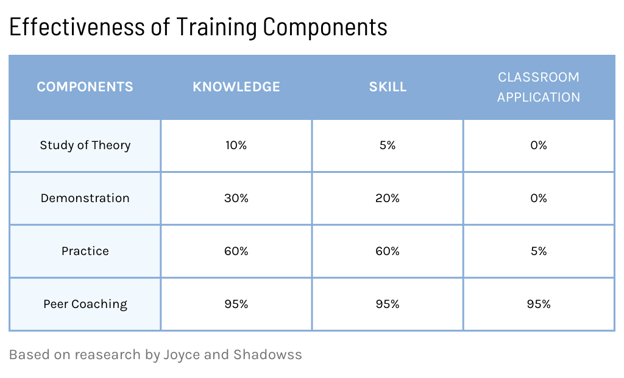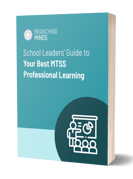Hooray! You've already laid the groundwork for MTSS success by establishing a clear vision for the work in collaboration with your colleagues. The initial hurdle of getting systems off the ground and providing basic training for staff members on board has been completed. But now, as you move toward full implementation and continuous growth, you're stepping into the big leagues.
This stage is critical. It's where MTSS implementation can either gain momentum or fall faster than a toddler learning to walk. If you find momentum fizzling out and MTSS fidelity seeming like a foreign concept to your staff, it's likely you've fallen into a common trap: treating MTSS professional development as a one-time thing.
Let's explore key mindset shifts needed to break free from this trap and sustain momentum through ongoing professional development.
MTSS Is a Long Game
The work of MTSS is urgent for students who are struggling, and teachers need collaboration and practical tools to meet those needs. At the same time, it’s important to set a sustainable, reasonable pace for training and implementation. In the context of MTSS, which involves layers of academic and behavioral support, this means beginning with the broad, basic elements that will start having an immediate impact, and steadily adding more specialized interventions and supports. For instance, a school might start by establishing universal screening processes and a reasonable set of Tier 1 interventions, then integrate more intensive Tier 2 and 3 strategies as their capacity develops.
It takes consistent effort to embed MTSS practice into the fabric of your school or district and see those tangible results. And that's perfectly okay — in fact, it's essential. It's a process of learning, adjusting, and refining over time.
💡 Download this Free Guide: Implementing MTSS at a Sustainable Pace
MTSS Revolves Around Data
Central to this work is the utilization of data. Data provides insight into what we need to prioritize. This is true not only for how we support students but also for how we support educators! Use data about implementation fidelity along with student outcomes to identify priorities for your professional development plan. Once these gaps are identified, use targeted professional development along with step-by-step action plans to facilitate ongoing improvement.
- Consider a survey for educators to inform your professional development. 💡 Access the Educator Reflection Questions from the School Leaders’ Guide to Your Best MTSS Professional Learning
- An MTSS solution like Branching Minds streamlines the process of collecting and analyzing data to identify students’ needs and monitor their progress effectively. 💡 Explore the MTSS Buyer’s Guide
MTSS Learning Is Continuous (For Everyone!)
💡 Want to learn more? Listen to this podcast conversation "From Theory to Practice: The Importance of PD for Sustainable MTSS."
The MTSS professional development playbook has three essential components: Learn, Apply, and Monitor.
- Learn: MTSS Professional Development is not just checking a box or a one-and-done deal. If so, you’ve already discovered that trying to tackle everything at once is a recipe for overwhelm, which leads to pushback and momentum fizzling out very quickly. Make sure your educators are continuously equipped with multiple PD opportunities, allowing them to transition from theory to application effectively.
💡 Take your staff's professional development to the next level with our School Leaders’ Guide to Your Best MTSS Professional Learning
- Apply: In sports, athletes practice a skill, but they also have coaches watching and giving in-the-moment feedback to make sure they are doing it right. Professional development should work the same way. We can't just send educators off with new strategies and hope for the best. We need to create opportunities for them to apply what they've learned and then monitor to ensure it's being done effectively.
- Monitor: Make observation and feedback a regular part of the continuous improvement process. Protect and prioritize time for admins to be in the classroom, observing and providing feedback, along with peer opportunities to learn from one another.
BONUS — Peer Coaching Leads to Success

Researchers Joyce and Showers found that when professional development covers theory, modeling, applied practice with feedback, and includes peer coaching with follow-up, the skills learned get used way more effectively (Joyce and Showers, 2002). Ultimately, incorporating these elements into our professional development sessions has the potential to enhance the meaningful and sustainable application of skills for our educators.
💡 Watch the webinar “No Teacher an Island: De-Privatizing the Classroom” for tips and resources on developing your own peer-coaching program.
Closing
If you're feeling the momentum wane and MTSS fidelity slipping, it's time to pivot and embrace ongoing professional development to keep motivation going strong. And don't shy away from educators’ feedback! Ask your teachers: "How do you want to learn this?" In many cases, teachers know exactly what they want and need to learn, and how they want that learning to look. By actively listening to their input and preferences, you can tailor professional development experiences to better meet their needs, further fueling momentum and fostering a culture of continuous improvement.
Dive deeper into developing top-notch professional development for your staff with our School Leaders’ Guide to Your Best MTSS Professional Learning
Key Takeaways:
- The work of MTSS is urgent, but it’s important to set a sustainable, reasonable pace for training and implementation.
- Professional development for MTSS isn't a one-time event; it requires continuous learning opportunities and adaptation for staff.
- Regularly provide feedback and check-ins to gauge progress and effectiveness, fostering a culture of continuous improvement and support.
|
|
Leave the PD planning to us!We offer tailored professional development for your district’s specific needs. Speak to a specialist today.
|
Citations
Joyce, B., and Showers, B. (2002). Student achievement through staff development (3rd ed.). Alexandria, VA: Association for Supervision and Curriculum Development.

About the author
Melanie Gonzalez
Melanie Gonzalez is the Social Media & Community Engagement Strategist for Branching Minds. She brings experience in digital media content strategy, social media management, online community building, multimedia development, and video storytelling. Melanie is passionate about fostering meaningful and diverse engagement and connecting educators with BRM resources to enhance their MTSS practices. Prior to joining Branching Minds, Melanie worked as a digital media coordinator and social media manager for Cabarrus County Schools, and a parent liaison at the school level.

Your MTSS Transformation Starts Here
Enhance your MTSS process. Book a Branching Minds demo today.













.png?width=1436&height=956&name=One%20Reason%20Your%20MTSS%20Might%20Be%20Failing%2c%20and%20What%20To%20Do%20About%20It%20(1).png)




.png?width=716&height=522&name=Tech-Learning-Most-Influential-Edtech-Product-2025(preview).png)

.png?width=716&height=522&name=MTSS-interventions-secondary-school(preview).png)